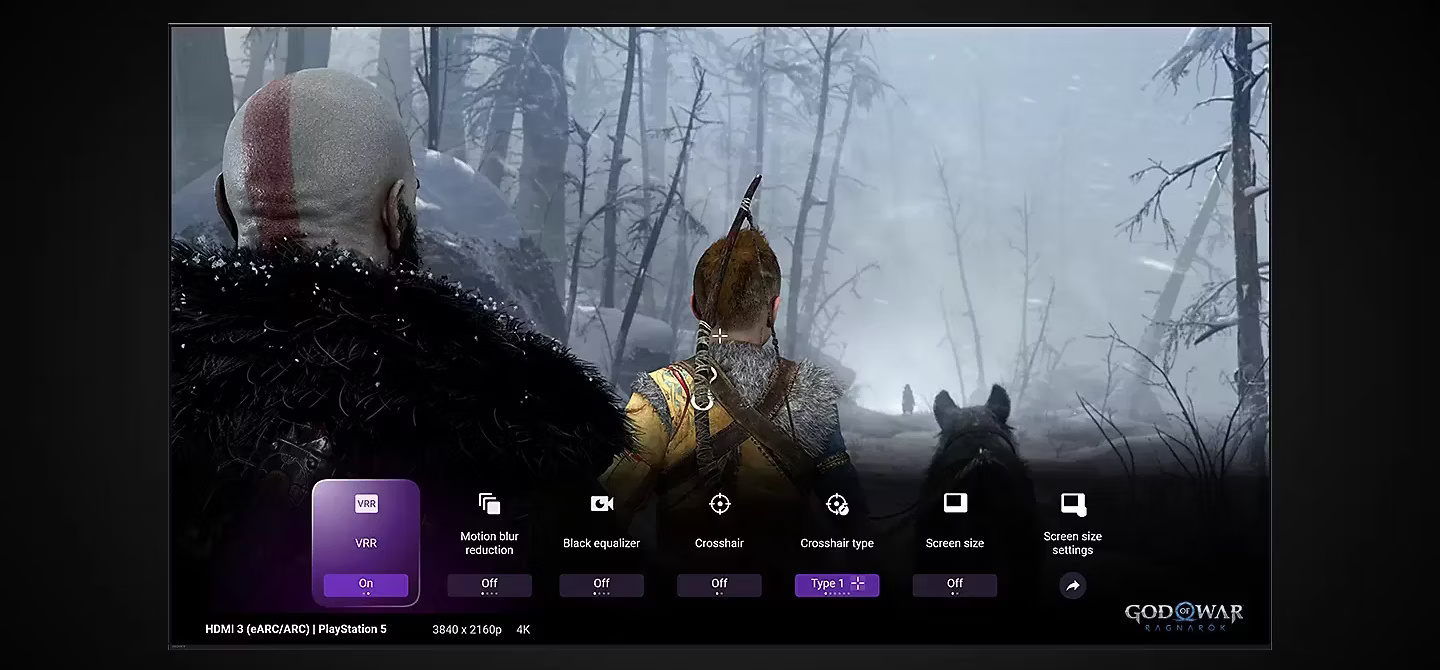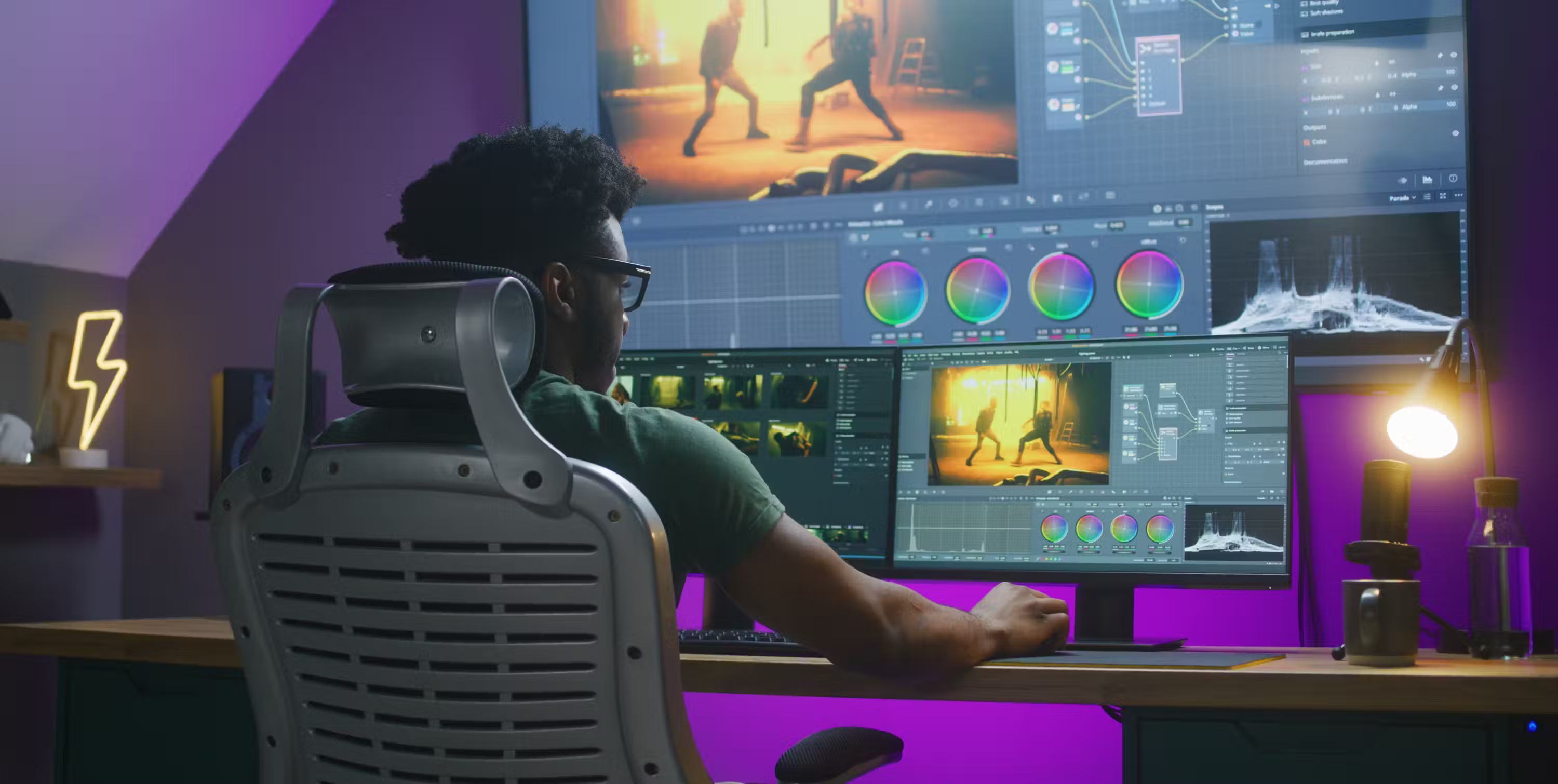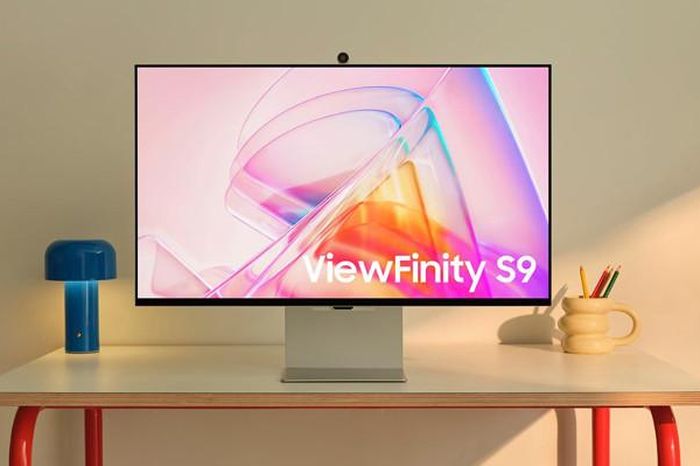7 things to consider before using your TV as a computer monitor
Using a TV as a monitor for a PC is not an experience everyone enjoys. So, before connecting your computer to your TV or moving your TV to your desk, consider these important factors first so you don't regret your decision.
1. Screen size
The difference in size between a regular computer screen and a TV may be a reason for you to consider replacing it. A larger screen may seem appealing at first, but this difference in size can cause quite a headache, especially if you plan to place it on your desk.
A 55-inch TV like the Samsung S90D can be so large that you don't have enough space on your desk to work. Also, unlike regular computer monitors, you can't tilt or swivel the TV.
Additionally, if you try to use the TV on your desk, you will have to sit too close to the TV, which also causes eye fatigue. That's because, with an extremely large TV, the eyes will have to move from side to side a lot to look at different areas of the screen.
It is not recommended to use a TV over 48 inches on a desk as this experience is not ideal for most people.
2. Screen resolution

The next important factor to consider is the TV's resolution. A Full HD 1080p TV will look worse than a computer monitor with the same resolution due to the large difference in size. Although both have a total of 2 million pixels, computer screens have more pixels per inch (due to their smaller size), which makes a big difference to the eyes. So, if you plan to use a 1080p TV, choose a size between 32 and 40 inches.
4K TVs are great for desks as long as they aren't large. For example, a 55-inch 4K TV like the Sony Bravia A95L has a pixel density of 80 pixels per inch. That's almost the same pixel density as a 27-inch 1080p display (81.59 PPI).
Remember, the smaller the TV and the higher the resolution, the more suitable it is as a computer monitor.
3. Input lag
Input lag is the time it takes to display any movement on the screen using a mouse or keyboard. When moving the mouse, the time required for the cursor on the screen to move according to the mouse movement is the input delay.
Most TVs have an input lag of 20 to 30 milliseconds, while nearly every typical PC monitor typically has an input lag of less than 5 milliseconds. If the TV is equipped with a gaming mode, the input lag will be in the single digits. Gaming monitors have even lower input lag, as little as 1 to 2 milliseconds.
Some high-end TVs today have latency close to that of computer screens. For example, the Samsung S90 QD-OLED TV has an input lag of 4.8 milliseconds at 4K/144Hz.
Although 20 milliseconds may not seem like much, if you plan to use your TV screen for gaming, the lower the input lag, the better. So, using a TV as a monitor may not be a good choice if you regularly play multiplayer online games.
4. Response time

Response time refers to the time it takes for each pixel on the panel to change color. Since most TV screens are designed for watching movies and videos, they prioritize good picture quality with high contrast and richer colors. However, all this image processing results in higher response times.
Dedicated PC monitors tend to provide sharper images and don't require as much processing, resulting in significantly lower response times.
On average, if a TV screen has a response time of about 15ms, the corresponding computer screen will have a response time of 5ms. Higher response times can make it difficult to play competitive games, leading to motion blur.
This is especially common with LCD, LED and mini-LED TVs. OLED TVs have the upper hand in this aspect because they have a near-instant response time (0.1-0.2 milliseconds). That's one of the advantages of buying an OLED TV.
5. Refresh rate
The term "Refresh Rate" refers to the number of times the screen updates to display a new frame or image per second. A standard TV has a refresh rate of 60Hz, meaning it can display 60 frames per second.
Gaming monitors, on the other hand, typically have a refresh rate of 144Hz, with some models having a refresh rate of up to 540Hz, like the Asus ROG Swift PG248QP. At higher refresh rates, everything moving on the screen looks significantly smoother. Some modern TVs also offer high refresh rates. For example, the LG G4 OLED TV supports frequencies up to 144Hz.
Screen refresh rate is very important when playing games, especially with competitive games. You'll immediately feel the difference in smoothness if you switch from a 144Hz monitor to a 60Hz TV; The game will feel jerky and have poorer response times.
6. Chroma subsampling
Chroma subsampling is a technique used to compress the size of an image. You won't see any difference in picture quality on most TVs. However, if your TV has a 4:2:0 chroma subsampling, you'll notice that text appears blurry when you look closely.
Before using the TV as a monitor, make sure the TV can switch to 4:4:4 or at least 4:2:2 chroma sampling. This way, the image quality will be insignificantly worse and the text will still be readable.
7. Color accuracy

Although image processing makes movies and videos look good on the screen, the colors seen aren't always accurate, at least on regular LCD TVs. Computer monitors tend to be more color accurate because they don't sacrifice accuracy to make the image pop.
However, modern TVs with mini-LED and OLED panels can outperform most displays in terms of color accuracy. So it all depends on the monitor and TV you currently have.
If you plan to edit photos, videos or perform color grading work, you should use a high-end TV from Sony, Samsung or LG, as these companies are famous for producing the most color-accurate TVs. on the market.
A TV may not fit on everyone's desk. Unless you have a mini-LED or OLED TV with all the features of a high-end screen, this article does not recommend using the TV for anything other than watching movies or videos.
For gaming, using a computer monitor is always better. But if you want a larger screen for your computer, consider setting up multiple monitors. Not only does it look good but it's also quite practical for multitasking.
You should read it
- How to Connect Two Monitors
- SnoopStick - Super tool to monitor Internet users
- How to Connect a Gaming Console to a Computer Monitor
- Where to buy a blood pressure monitor?
- Use WinPatrol to monitor computers
- Homemade youtuber 'portable' computer has two unique screens, weighing 10kg
- 11 ways to start the Performance Monitor performance monitor in Windows
- Learn about Activity Monitor on Mac
May be interested
- Homemade youtuber 'portable' computer has two unique screens, weighing 10kg
 inspired by the touchbar bar on the macbook pro and a macbook pro concept with two monitors, the channel owner youtube anitomicals c has created a mobile computer with two screens that keep tech lovers interested.
inspired by the touchbar bar on the macbook pro and a macbook pro concept with two monitors, the channel owner youtube anitomicals c has created a mobile computer with two screens that keep tech lovers interested. - 11 ways to start the Performance Monitor performance monitor in Windows
 performance monitor is a sophisticated tool that can be used to monitor the performance of your windows computer or device.
performance monitor is a sophisticated tool that can be used to monitor the performance of your windows computer or device. - How to Use a TV as a Computer Monitor
 want to experience computing on a larger screen? for example, if you need to practice a presentation but don't have a projector, you can use a 50' hd tv. or you plan to turn your laptop into a desktop but don't have an external monitor. most computers can easily connect to modern tvs, giving you a much larger screen.
want to experience computing on a larger screen? for example, if you need to practice a presentation but don't have a projector, you can use a 50' hd tv. or you plan to turn your laptop into a desktop but don't have an external monitor. most computers can easily connect to modern tvs, giving you a much larger screen. - How is a gaming monitor different from a regular monitor?
 want to buy yourself a gaming monitor, but you don't know if a gaming monitor is different from a regular monitor or not, is it worth your investment?
want to buy yourself a gaming monitor, but you don't know if a gaming monitor is different from a regular monitor or not, is it worth your investment? - Learn about Activity Monitor on Mac
 the activity monitor displays a variety of resources used on the system in real time, including processes, disk activity, memory usage and more.
the activity monitor displays a variety of resources used on the system in real time, including processes, disk activity, memory usage and more. - How to work with Performance Monitor performance monitor in Windows
 have you ever heard about performance monitor or perfmon.exe or perfmon.msc in windows?
have you ever heard about performance monitor or perfmon.exe or perfmon.msc in windows? - Should I choose an ultra-wide monitor or a dual monitor setup?
 the extra screen space is great for many reasons, but one of the biggest is the efficiency it delivers.
the extra screen space is great for many reasons, but one of the biggest is the efficiency it delivers. - How to Control the Brightness of Your Computer With Windows 7
 this wikihow teaches you how to raise or lower your computer's brightness on windows 7 laptop. most desktop computers use an external monitor, meaning that the brightness must be altered by using the monitor's physically built-in buttons...
this wikihow teaches you how to raise or lower your computer's brightness on windows 7 laptop. most desktop computers use an external monitor, meaning that the brightness must be altered by using the monitor's physically built-in buttons... - How to fix a blurry external display
 a dim external monitor can disrupt productivity and cause eye strain. luckily, there are plenty of things you can do to fix a dim display!
a dim external monitor can disrupt productivity and cause eye strain. luckily, there are plenty of things you can do to fix a dim display! - 4 mobile screen models are worth possession of today
 4 choices worth considering, promising to meet the requirements of the most demanding users at different levels of work.
4 choices worth considering, promising to meet the requirements of the most demanding users at different levels of work.










 Enhance your experience with the ViewFinity S9 monitor and T7 Shield portable hard drive
Enhance your experience with the ViewFinity S9 monitor and T7 Shield portable hard drive What is HDR10+?
What is HDR10+? 4 easy ways to connect your new Soundbar to your TV
4 easy ways to connect your new Soundbar to your TV How to project Android screen on TV is extremely easy
How to project Android screen on TV is extremely easy Should I buy a QLED, OLED or LED TV?
Should I buy a QLED, OLED or LED TV? 5 best cheap TVs for gaming
5 best cheap TVs for gaming